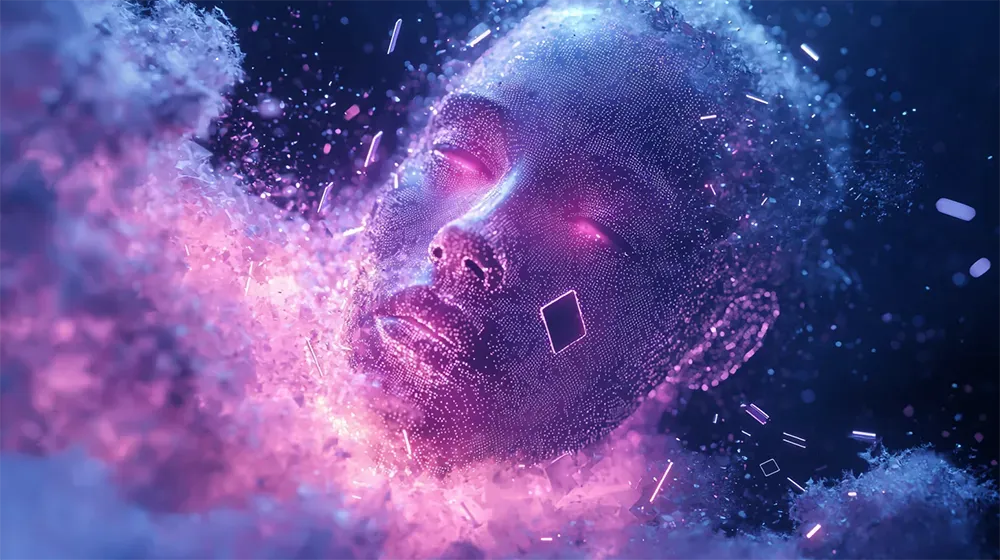Understanding Computer Vision Through a Futurist Speaker's Insight

Understanding Computer Vision Through a Futurist Speaker's Insight
Computer vision is an exciting field that has the potential to revolutionize various industries. With the advent of advanced technology and machine learning algorithms, computers are now able to understand and interpret visual information, just like humans do. In this article, we will delve into the concept of computer vision and explore its practical applications, all from the insightful perspective of a futurist speaker.
Understanding the Concept of Computer Vision
At its core, computer vision is the ability of machines to analyze and understand visual data. It involves the use of algorithms and models to process images or videos, enabling computers to extract meaningful information from them. This information can be used for a wide range of purposes, such as object recognition, image classification, and even facial recognition.
Computer vision goes beyond simply detecting and recognizing objects in images. It also involves understanding the context and depth of the visual data, allowing machines to make more informed decisions based on what they "see." This ability opens up a world of possibilities in fields like autonomous vehicles, healthcare, and even entertainment.
One fascinating application of computer vision is in the field of autonomous vehicles. With the advancement of computer vision technology, self-driving cars are becoming a reality. These vehicles are equipped with cameras and sensors that constantly capture and analyze the surrounding environment. By using computer vision algorithms, they can detect and identify objects such as pedestrians, traffic signs, and other vehicles. This information is then used to make decisions in real-time, ensuring safe and efficient navigation.
In the healthcare industry, computer vision plays a crucial role in medical imaging. Medical professionals rely on accurate and efficient analysis of medical images to diagnose and treat various conditions. Computer vision algorithms can assist in detecting abnormalities in X-rays, MRIs, and CT scans, helping doctors make more accurate diagnoses. Additionally, computer vision can aid in surgical procedures by providing real-time feedback and guidance to surgeons, enhancing precision and reducing risks.
Computer vision also has the potential to revolutionize the entertainment industry. With the rise of virtual reality (VR) and augmented reality (AR), computer vision algorithms can enhance the immersive experience for users. By tracking the movements and gestures of users, computer vision enables realistic interactions with virtual objects and environments. This technology has the potential to transform gaming, simulation, and even storytelling, creating new and exciting forms of entertainment.
Furthermore, computer vision is not limited to these specific fields. It has applications in security systems, retail analytics, agriculture, and many other industries. For example, computer vision can be used to monitor and analyze surveillance footage, identifying suspicious activities or individuals. In retail, computer vision can analyze customer behavior and preferences, providing valuable insights for marketing strategies. In agriculture, computer vision can assist in crop monitoring, disease detection, and yield estimation, optimizing farming practices.
In conclusion, computer vision is a rapidly advancing field that holds immense potential for various industries. By enabling machines to analyze and understand visual data, computer vision opens up new possibilities in autonomous vehicles, healthcare, entertainment, security, retail, agriculture, and beyond. As technology continues to evolve, we can expect computer vision to play an increasingly important role in our lives, enhancing efficiency, accuracy, and innovation.
The Role of a Futurist Speaker in Simplifying Computer Vision
Now, you may be wondering, what does a futurist speaker have to do with computer vision? Well, the role of a futurist speaker is to bridge the gap between complex technological concepts and the general public. They have the unique ability to simplify and explain cutting-edge technologies, like computer vision, in a way that is accessible to everyone.
A futurist speaker can break down the intricacies of computer vision and highlight its impact on our everyday lives. They can provide real-world examples and relatable analogies to make the subject more relatable and understandable. Through their engaging speaking style, they can ignite curiosity in their audience and inspire them to embrace the possibilities that computer vision holds.
Imagine attending a conference where a futurist speaker takes the stage. As they begin their presentation on computer vision, they captivate the audience with a compelling story. They paint a vivid picture of a world where machines can see and interpret visual data, just like humans. The speaker explains how computer vision algorithms can analyze images and videos, enabling applications such as facial recognition, object detection, and autonomous vehicles.
With their expert knowledge, the futurist speaker delves into the technical aspects of computer vision. They explain the underlying principles, such as image processing, pattern recognition, and machine learning algorithms. But they don't stop there. They understand that not everyone in the audience may have a background in computer science, so they take the time to simplify these concepts further.
Using relatable analogies, the futurist speaker compares computer vision to the human visual system. They explain how our eyes capture light, which is then processed by our brain to form images and make sense of the world around us. Similarly, computer vision systems use cameras to capture visual data, which is then processed by algorithms to extract meaningful information.
The speaker goes on to discuss the practical applications of computer vision in various industries. They talk about how computer vision is revolutionizing healthcare by assisting in medical diagnosis, monitoring patient health, and even performing surgeries with precision. They also highlight its impact on retail, where computer vision enables cashier-less stores and personalized shopping experiences.
Furthermore, the futurist speaker emphasizes the ethical considerations surrounding computer vision. They address concerns about privacy, surveillance, and potential biases in algorithms. They discuss the importance of responsible development and deployment of computer vision technologies, ensuring that they benefit society as a whole.
Throughout the presentation, the futurist speaker engages the audience with interactive demonstrations. They showcase how computer vision algorithms can recognize objects in images, track movements, and even interpret emotions from facial expressions. These demonstrations not only make the subject matter more tangible but also leave the audience in awe of the capabilities of computer vision.
In conclusion, a futurist speaker plays a crucial role in simplifying computer vision for the general public. They have the ability to break down complex concepts, provide relatable examples, and ignite curiosity. By bridging the gap between technology and society, futurist speakers inspire individuals to embrace the potential of computer vision and its impact on our lives.
Decoding the Impact of Computer Vision on Business Operations
Computer vision is not just a buzzword - it has the potential to revolutionize business operations across various industries. By automating tasks that were once performed by humans, organizations can streamline their workflows, increase efficiency, and reduce costs.
For example, in the retail sector, computer vision can be used for shelf monitoring and inventory management. By analyzing real-time images, businesses can track the availability of products, identify out-of-stock items, and even optimize shelf layouts to improve sales. This not only saves time but also enhances the overall customer experience.
Furthermore, in the manufacturing industry, computer vision can play a crucial role in quality control. By inspecting products and identifying defects or inconsistencies, machines can ensure that only the highest quality goods are delivered to customers. This eliminates the need for manual inspections and reduces the chances of human error.
However, the impact of computer vision extends beyond just retail and manufacturing. In the healthcare industry, for instance, computer vision can aid in the diagnosis of diseases. By analyzing medical images, such as X-rays or MRIs, computer vision algorithms can detect abnormalities or patterns that may not be easily visible to the human eye. This can lead to earlier detection and more accurate diagnoses, ultimately saving lives.
Moreover, computer vision can also revolutionize the transportation sector. By using cameras and sensors, computer vision systems can assist in autonomous vehicles, enabling them to navigate and make decisions based on real-time visual data. This has the potential to greatly improve road safety and reduce accidents caused by human error.
Another industry that can benefit from computer vision is agriculture. By analyzing aerial images or drone footage, computer vision algorithms can identify crop health, detect pests or diseases, and even optimize irrigation systems. This can help farmers make data-driven decisions, increase crop yields, and reduce the use of pesticides, leading to more sustainable and efficient farming practices.
Additionally, computer vision can have a significant impact on the security and surveillance industry. By analyzing video feeds, computer vision algorithms can detect suspicious activities, identify individuals, and even track objects in real-time. This can enhance public safety, improve response times, and aid in investigations.
As technology continues to advance, the potential applications of computer vision are only limited by our imagination. From retail to healthcare, manufacturing to agriculture, and transportation to security, computer vision has the power to transform the way businesses operate and revolutionize various industries. Embracing this technology can lead to increased productivity, improved decision-making, and ultimately, a competitive edge in the market.
How a Futurist Speaker Links Computer Vision to Future Technology Trends
A futurist speaker can help us understand the link between computer vision and future technology trends. They are well-versed in the latest advancements and can provide insights into how computer vision will shape the future.
One such trend is the integration of computer vision with augmented reality (AR) and virtual reality (VR) technologies. By combining computer vision algorithms with AR/VR headsets, we can create immersive and interactive experiences. Imagine being able to see virtual objects seamlessly integrated into the real world or interact with holographic images - the possibilities are endless.
Additionally, computer vision is revolutionizing the retail industry. With the help of computer vision technology, stores can now offer personalized shopping experiences. By analyzing customer behavior and preferences, computer vision algorithms can recommend products tailored to individual needs. This not only enhances the shopping experience but also increases customer satisfaction and loyalty.
Another exciting trend is the use of computer vision in healthcare. With the ability to analyze medical images, such as X-rays or MRIs, machines can assist doctors in diagnosis and treatment planning. This not only speeds up the process but also improves accuracy, leading to better patient outcomes.
Furthermore, computer vision is playing a crucial role in the automotive industry. With the development of self-driving cars, computer vision algorithms are used to detect and recognize objects on the road, such as pedestrians, traffic signs, and other vehicles. This technology enables autonomous vehicles to make real-time decisions, ensuring safer and more efficient transportation.
In the field of agriculture, computer vision is being utilized to optimize crop management. By analyzing aerial images captured by drones or satellites, computer vision algorithms can identify crop health, detect pests or diseases, and even estimate crop yield. This information helps farmers make data-driven decisions, leading to increased productivity and sustainability.
Moreover, computer vision is being applied in the field of security and surveillance. By using advanced video analytics, computer vision algorithms can detect suspicious activities, identify individuals, and track objects in real-time. This technology enhances public safety and enables proactive measures to prevent crimes.
In conclusion, the integration of computer vision with various industries is transforming the way we live and work. From augmented reality to healthcare, retail, automotive, agriculture, and security, computer vision is paving the way for a future where machines can perceive and understand the world around us. A futurist speaker can provide valuable insights into these trends, helping us navigate the exciting possibilities that lie ahead.
Practical Applications and Future Predictions for Computer Vision
Computer vision has already found its way into numerous practical applications, and its potential is far from realized. In the transportation sector, computer vision enables self-driving cars to navigate roads and detect obstacles. In the security industry, it helps in surveillance and facial recognition systems.
Looking ahead, the future of computer vision seems promising. As technology continues to evolve, we can expect even more advanced and sophisticated applications. From personalized shopping experiences to fully automated factories, the possibilities are limitless.
Ultimately, understanding computer vision through a futurist speaker's insight allows us to envision a world where machines can truly see and interpret the world around them. This knowledge empowers us to embrace the potential of computer vision and discover innovative ways to leverage this transformative technology.
Frequently Asked Questions
1. What is computer vision?
Computer vision is the ability of machines to analyze and understand visual data. It involves the use of algorithms and models to process images or videos, enabling computers to extract meaningful information from them.
2. What are the practical applications of computer vision?
Computer vision has practical applications in various industries. It can be used in autonomous vehicles for object recognition and navigation. In healthcare, it aids in medical imaging for accurate diagnoses. It also enhances entertainment experiences through augmented reality and virtual reality.
3. How does a futurist speaker contribute to understanding computer vision?
A futurist speaker simplifies complex technological concepts like computer vision for the general public. They provide relatable examples and analogies to make the subject more understandable. They also highlight the impact of computer vision on different industries and future technology trends.
Contact a Futurist Speaker for your event
Are you ready to take your event to the next level? Look no further than Dr. Mark van Rijmenam, a renowned futurist speaker who can bring a fresh perspective and insightful knowledge to your audience. With his expertise in cutting-edge technologies like computer vision, he can captivate your attendees and inspire them to embrace the possibilities of the future.
By hiring Dr. Mark van Rijmenam as your futurist speaker, you are ensuring a dynamic and engaging event that will leave a lasting impact on your audience. His ability to simplify complex concepts, provide relatable examples, and ignite curiosity will keep your attendees on the edge of their seats.
Don't miss out on the opportunity to have Dr. Mark van Rijmenam as a speaker at your next event. Contact us now, and we will be in touch within 24 hours to discuss how we can make your event a resounding success.
Thanks for your inquiry
We have sent you a copy of your request and we will be in touch within 24 hours on business days.
If you do not receive an email from us by then, please check your spam mailbox and whitelist email addresses from @thedigitalspeaker.com.
In the meantime, feel free to learn more about The Digital Speaker here.
Or read The Digital Speaker's latest articles here.





